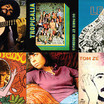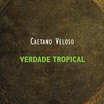Eubioticamente atraídos
the entropic tropic of tropicália
Brazilian views
THE ENTROPIC TROPIC OF TROPICÁLIA
Marcio Chamie
O Estado de São Paulo, Apri l4, 1968.
Historically and sociologically, Tropicalism emerged with Gilberto Freyre, with his telluric vision in which the Brazilian citizen would assume a colonial, metropolitan,and hybrid complexity in order to have a cultural personality; a personality that is rather dubious. Tropicalism as a quotidian and anthropological sensation emerged with Caetano Veloso. His is a planetary vision in which Brazilian man accepts existential liberation along the lines of Macunaíma: his character lay in his very lack of character. The Tropicalism of the solitary Gilberto Freyre got caught up Ín a folkloric understanding of Brazilian destiny. For him, we would be today and in the future, folkloric flowers of order and progress.” In otherwords, we would hold onto our Lusoindigenous identity even when faced with the machines that are transforming us into an industrialized society. The Tropicalism of Gilberto Freyre, by remote controI, would find its true popular and musical expression in the Varig Airlines jingle in which Pedro Alvares finds the “good land” and the “generous people” described by Caminha in the chronicles of his first voyage to Brazil. The jingle was used as a street saíriba during last carnival.
In its own way, Caetano Veloso’s Tropicalism attacks our provincial and folkloric instincts. It calls for a collective instinct and is entirely the product of mass culture’s communication, founded in our technological age. Gilberto Freyre looks for a Cartesian coherence, in deference to the supposed roots and traditions of Brazilian identity. Caetano draws from a baroque incoherence, because LSD is as Baroque as a psychedelic hallucination. The sociologist’s Tropicalism believes Ín the diachronic permanence of the .Brazilian personality; it tries to explain, over four and a ha1f centuries, what distinguishes us as colonizers, urbanites, and independent citizens following the reign of Pedro I. He tries to explain and distinguish the master’s house from the slave quarters, the region from the nation. His “Regionalist Manifesto,” for example, is explanatory and his complicity with Portuguese colonialism overseas, although not explicitly connected, is part of the same discursive universe as Jorge de Lima’s poem “Essa Nega Fulô,” the novels of Graciliano Ramos, and the poetry of João Cabral de MeIo Neto.
Caetano’s Tropicalism, on the other hand, only permits a synchronic contingency of the volume of information that the planetary channels of today’s civilization release into daily life.
Furthermore, Gilberto is from Pernambuco, Caetano Veloso from Bahia. Pernambuco has the thin and dry tradition of sugar cane, that prototypical plant that served as the model for MeIo Neto’s bane flute. Bahia has the fat and round tradition of tobacco and cocoa, whose anarchical metamorphosis blows through Jorge Amado and viblently expands in Glauber Rocha. Pernambucan Cartesianism, in its dry clarity, is redundantly blessed with solar verticality. Bahian Baroque is abundant, blessed with luminous horizontality, in its moist shadows. Pernambuco has a limpid, sharp, and linear discourse, even though the stretches of the Capiberibe River are dirty. In Bahia, the totality has always exploded, in a multilateral, anti-linear fashion, since, the days of Gregório de Matos, who wrote trilingual poems that nailed down, in a single text, the many shades of a single political situation.
There it is: on the one hand, the discourse of cause and effect inside in its successive rigor; on the other hand, the concentrated totality, inside simultaneous ardor. The first would join together the word tropical with the suffix ism; the second would bring together the word with the suffix ália. Every ism is an extensive program, loaded with principIes and norms, and every ália (even now, Gianfrancesco Guarnieri writes the piar Animália) is a composite of disparate and heterogeneous elements.
In these two conceptions, what each signifies alone and in relation to the other is at play. The first carries with it the presupposition of redundancy that, in information theory, leads to “triviality,” the absence ofthe unforeseen and even of co-authorship. The second enshrines “probability,” deified disorder, and for that reason, concedes to its readers and listeners the possibility of creative interference in the context of the lyric and song presented to them. The first exposes an already saturated message, establishing a clean passage, an absence of “white noise” between the producer and its reception. The second proposes a message full of ambivalence, and inaugurates an area of “possibilities,” fertile soil for interpretations, projections, connections, and free association. The first is the closed fact of understanding; the second, the open field of entropy.
If entropy, according to Umberto Eco, is the measure of disorder and the unexpected, the language of “Tropicália” is, point for point, entropic. It is language that forces us to say that every Brazilian artistic movement, until now enemies of entropy, carne in through the “sink” and notthrough the “pipe.” And why? Because the language of”Tropicália” is an uninhibited collage of references, chefies, noises and phrases drawn from universes that are isolated in space and time. The organization of its rhythm and structure propagares the juxtaposition of synchfonic fragments, cultural bits and pieces, dicta, and junk. In it, the present is in the past, the past is in the future, and vice versa, according to the agitation and the very excess of tropical nature. With this excess, “Tropicália” erects an afilicted, historical portrait, offered en masse, as if the listener remained ideally equidistant from a tumuItuous panorama of facts, things, events. Its clips and clippin offer citations and transcrip without links in an invoked familiarity of meaningful relations.
Really, everything began with the invocation of Villa-Lobos, the least elaborate, most dumbly Brazilian, who with the help of coconuts and berimbaus, subliminally suggests parts of the Letter of Pero Vaz [the scribe who wrote me first letter back to the King of Portugal.] Later the exuberant Iyrics erupt, the pastiche and parody with which Caetano Veloso sews and cooks, in a confident and empirical gesture, what he knows and doesn’t know , what he heard about and thought he understood. In the way, the firs two verses are a transcription adapted from two dicta from the praxis text “Caminhão de transporte: duas mãos” Transport Vehicle: two hands.) The text reads: “through the delta, the hawk, beneath the load, the truck.” Caetano sings, “above the head, airplanes, under my feet the trucks.” Alternating invocations follow in a crescendo that evoke the automatic language of the surrealists, newspaper columns, and authologies of literary styles and images. Caetano says: “pointed to the cliffs, my nose, I organize the movement, I direct the carnival, I inaugurate a munument, on the central high plains of the country, long life bossa, long life the straw huts.” The associations between “nose” and “bossa,” “movement” and “carnival,” “monument” and “straw huts” summarize the critical disorder with which it is possible to understend a tropical-esque disorder of intentions. It’s as if Caetano was telling us: we don’t know where our noses are, but we have bossa nova to take certain initiatives; we organize movements (including political movements), but everything ends up in a camival; we construct great monuments (like Brasília), but our mentality is still that of straw huts. These contradictions appear to us like a destiny or hot fatality that place on Caetano, and us, those “great eyes” of the owl. In the end Brasília is side by side with the Amazon jungle, where there is always a great big-eyed snake looking at MacunaÍIna. ”
In the second stanza, the singer notes, “the monument is made of crepe paper and silver/ the green eyes ofthe mulata/ the hair rudes the moon behind a green bush/ of the backlands/ the monuments have no door/ the entrance is an old street Narrowand crooked/ [and] on the knee, the smiling child, ugly and dead/ extends its hand/ long tive the bush/longlive the mulata.” Here, the planetary instinct shines brightly. Caetano has an eye on José de Alencar, Olavo Bilac and Catulo da Paixão Cearense, and another on the hard ground of Brazil. The song makes reference to Catulo’s “moon on the back1ands,” and Bilac’s “nature in perpetual party,” with which our etemal, Romantic, and Pamassian “green forest” is connoted. Alencar, who further down offers us bis Iracema, claims the “black hair,” the “green eyes” and absent “honey lips.” Reality is both hard and dreamlike. Every concrete monument(Brasilia, pIanted on the central high plains) Wil1 end up being “made of paper” when it is juxtaposed with this fantastic child, a little Hieronymous Bosch monster, “smiling, ugly and dead.” The rest is taken care of by the mulata who merits applause and praise.
In the third stanza, Caetano Veloso’s Tropicalism mixes the beginning of the second act of the play O Rei da Vela (fhe Candle King) with images drawn from Lautréamont and Rimbaud. There it is wrltten: “In the inner patio there is a swimming pool/ with blue water of Amaralina/ coconut trees, breeze and northeastem speech/ and headlights/ in the right hand, there is a rose bush/ guaranteeing eternal spring/ and in the garden, vultures hover/ the whole afternoon/ among sunfiowers/ long live Maria/long live Bahia.” The vivid symbol of tropical underdevelopment is more the swimming pool than the ocean The United States seeks to acquire a share of tropicality for tourism in the suspended swimming pools of Miami. And in Brazil, the prosperous family and the high bourgeoisie proudIy loves the economic stage that permits them to have a square or rectangle of blue water. Swimming pool and car (“the headlights”) are Olympian (from Olympus) and Hollywood-esque symptoms, as the French philosopher Edgar Morin claims. In this climate, the presente of d1e vuIture, which is less metaphysicaI than Edgar AlIen Poe’s raven, forces the existent, impressionist relationship between flowers and oracular birds in the poetry of Lautréamont and Rimbaud. Baudelaire could have also been evoked with his black springs. For that reason, long live Bahia, whose Amaralina is not different than the African beaches that would attract until his death the passionate poet of A Season in Hell.
The fourth stanza speaks of a person-owl, without a face, without body, but with big eyes, looking at Caetano in the dark. Who could this hidden subject of Tropicália be? The myth of that incamation of hot fatality that overflows in the stock of Amazonian fables, swollen with the tropics, and with its ghosts always on the trai( of Macunaíma and the poet Mario de Andrade? The bloodIess Worm, the Siren, the Mother of Water, the Bad-Thing or the and1ropomorphic figure of a celestial constellation into which our cursed hero with no character became transformed? In Veloso’s de1irious notes, entropy is the very closed body of dissonance itself; bringing together cowboy movies with geographic citations of lpanema. Caetano writes: “on the left wrist “western shoot-outs” I in his veins flows very little blood/ but its heart beats to the sound of the tambourine/ between dissonant chords/ladies and gentleman/ he sets bis big eyes/ on me/long tive Iracema! long tive Ipanema.” Those eyes are notthe eyes of Alencar’s heroine. Nevertheless, the “angry green seas” of the novelist from Ceará are the same that wash over the sophisticated beach in Rio de Janeiro.
Finally, in the last stanza, daily life alleviates the entropic tension of “Topicália.” Caetano returns to the beginning with “boss and “countryside” (instead of”straw huts”), through a deliberately light critique of Brazilian urban mass media which is really a disaster. At this moment, juxtaposing past and the present (“Iong the band/ Carmen Miranda” everything becomes explicit “Sondar is the Fino da Bossa/ Monday is the pits/ Tuesday is the farm, nevertheless/ the monument is quite modern/ you said nothing about the model of my suit/ let all also go to hell/ my dear/ long live the band/ Carmen Miranda. The citations are quite clear: Chico Buarque de Holanda, Roberto Carlos, Elis Regina’s TV show and Carmen Miranda, the great feminine and tropical idol of the past. In this collage of names, from today and yesterday, mass media is stamped in a familial disorder. The monument (previously described as made of “crepe papel and silver”) becomes moder and the very figure of the composer surfaces in psychedelic desire: his suit is gaudy and his hair is a Baroque mix of barbed wire and tobacco rolIs. We say: a physical summation. A synchronic and physiognomic clipping of a Tropicália that, being Brazilian, tries to identify with a certain entropic profusion occurring in other parts of the planet Earth, placed for all to see by the papers, television, or a Telstar satellite.
As we said at the beginning ofthis essay, the tropics sociological1y and historically produced Gilberto Freyre. The tropics as an everyday anthropological sensation produced Caetano Veloso. Freyre wants to see the world through the regional, through tradition and nation. Caetano sees the country through the world. One flows into Tropicalism, the other, into Tropicália. Two conceptions with two destinies: the firstwants, diachronically, to keep us pretty and portuguese, maintaining the umbilical cord between the colony and the metropolis after independente; the second proposes an integrative simultaneity, in such a way that Brasilia, Vietnam, the Beatles, or the European Common Market accumulate in an often contradictory mass of information that we need to know and comprehend in the here and now. Since it is expository and successive, Tropicalism involves Brazilian cultural manifestations from Caminha’s letter to the entire cycle of 1922 (including Brazilwood, green-yellowism, anthropophagy and modernist joke-poems). Since it is totalizing and simultaneous, Tropicália constitutes a linguistic phenomenon true to an era that, being technologically and culturalIy oriented toward mass media, provoked a heterogenous summoning of facts and their meanings. A pop-kitsch phenomenon. Freyre’s Tropicalism found shelter in the vertical consumption of the book; Veloso’s Tropicália, in the horizontal consumption of the record, which can be heard at any given moment by almost the entire population of the country.
In alI of this, nevertheless, one thing might still be in doubt: whether the ism and the ália will merely survive and feed off their novelty, without pulling anyone from their depression, be it the historical (chronic and diachronic) depression or the momentary, symptomatic, and synchronic depression.























